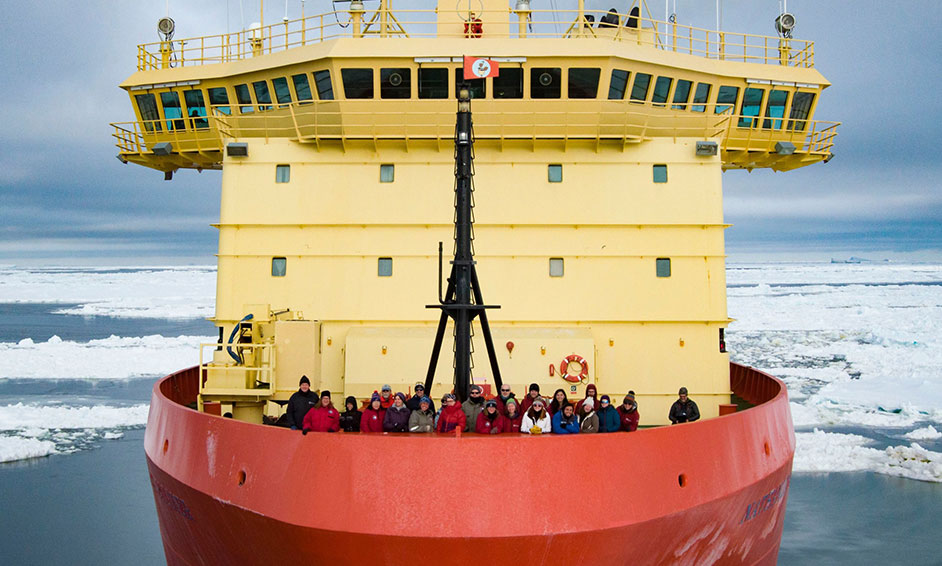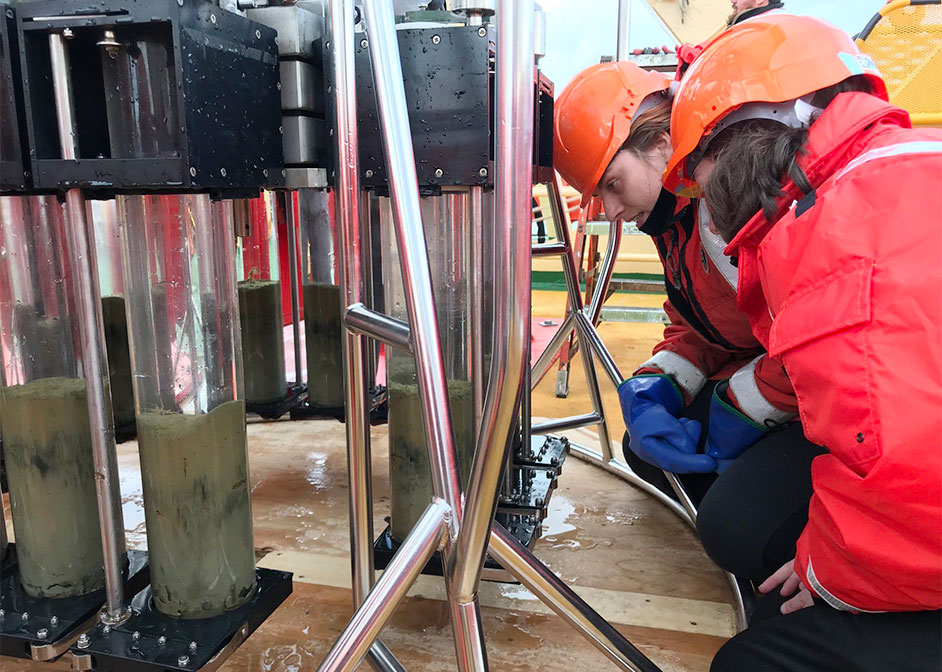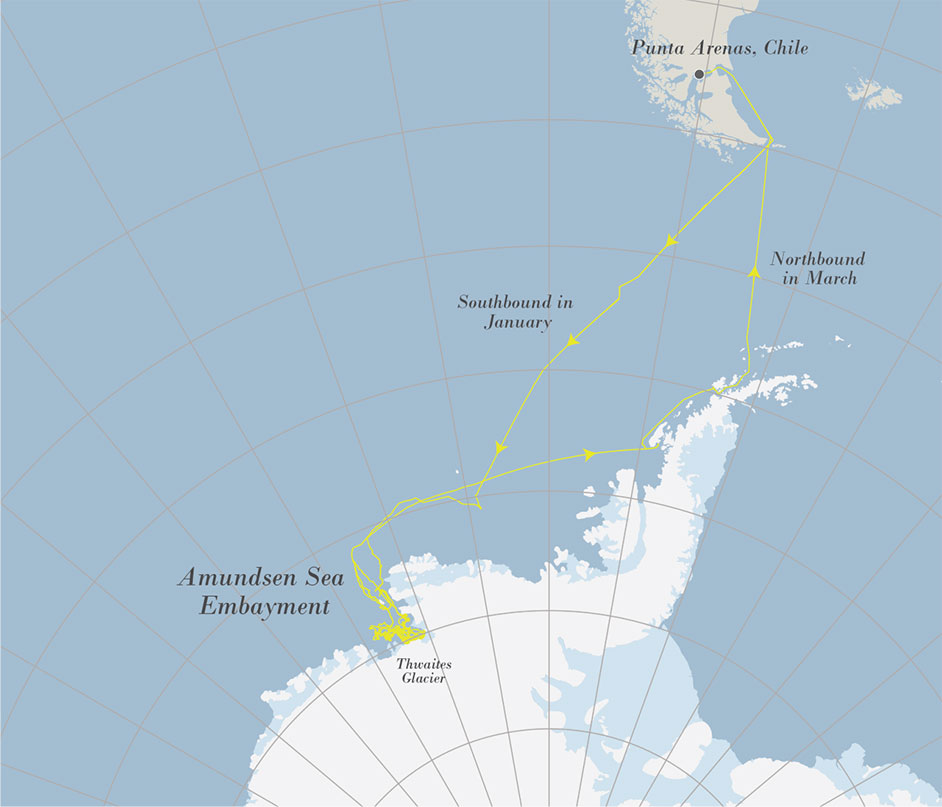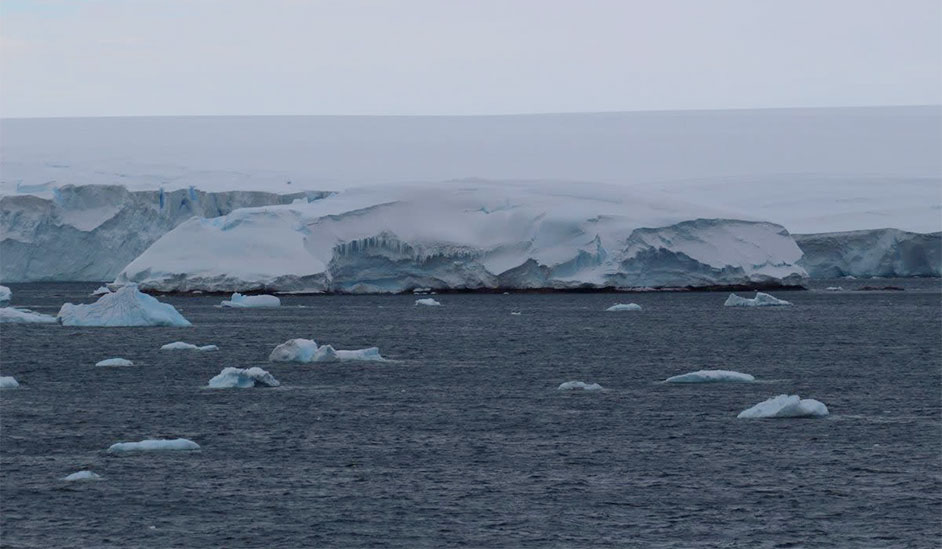Julia Wellner spent two months in one of the most remote locations on earth. The world changed while she was gone, but the work goes on.
Julia Wellner and other crew members for this year’s Thwaites Glacier Offshore Research Project stepped onto the deck of the Nathaniel B. Palmer in January, leaving from a crowded pier in Punta Arenas, Chile, and sailing to the west coast of Antarctica.

See UH Photo Essay
They returned to a near-deserted port more than two months later, remaining offshore until it was time to travel directly to the airport and home. But while the rest of us were working from home and sheltering in place, Wellner, her fellow researchers and a group of students – 59 people in all – were in a quarantine of a different sort, surrounded by ice and gathering data to build more accurate models of future sea level rise and climate change.
They rescued a fishing boat trapped in the ice and discovered a previously unknown island, too.

Wellner is associate professor of geology at the University of Houston and one of two principal investigators for an initiative of the International Thwaites Glacier Collaboration, studying the stability of the Thwaites Glacier in West Antarctica. She also served as chief scientist for the recent cruise, a project funded by the U.S. National Science Foundation and the Natural Environment Research Council in the United Kingdom. Two UH students were along for the research adventure, Laura Taylor, an undergraduate majoring in geology, and Rachel Clark, a Ph.D. student studying marine geology and geophysics.
The cruise will be part of a four-part documentary series, “Big Ice,” set to air in 2021. Now back in Houston, Wellner took time to answer a few questions.
Q: It must be a little surreal to come back to the world and find it locked down in the midst of a viral pandemic.
JW: It is different. In many ways, we feel like we’ve been in quarantine longer than anybody else. We sailed from Chile on January 25th, so I haven’t been in a store or a restaurant since January. We were essentially in quarantine with each other that whole time.
Q: Let’s start with the scientific mission for this cruise. What were your goals?
JW: The International Thwaites Glacier Collaboration focuses on Thwaites Glacier because it is considered the part of west Antarctica that is most susceptible to change. It is sometimes called the “Doomsday Glacier.” I think it’s better to think of it as the cork in the bottle, holding back a huge amount of ice.
As ice melts, the sea level rises. Thwaites is the most rapidly changing large glacier on the planet. So we were there to learn from it.
As a geologist, I look at sediments. I don’t study ice, and I don’t model future (climate) change. But the people that do model future change need to understand what has happened in the past for their models. We only have instrumental records of how the ice has changed over the last couple of decades. Through this research, we look further back in time.

In my lab at UH, we use lead-210 (210Pb) dating (a method of determining the age of sediments using lead isotopes), and that can go back for about 100 years. We also do radiocarbon dating, which allows us to date sediments back a few thousand years.
My project is focused on the recent retreat of Thwaites Glacier and understanding the drivers of that over the last century. We know what is happening today, but we don’t know how much of what is happening now is related to recent global climate change vs. how much is part of longer-term cycles. We’re pretty sure it is largely related to recent climate change, but we still need to understand the mechanisms.
Q: The first Thwaites voyage took place in 2019, and although you were actually on another research vessel off the coast of Antarctica at the time, you were still co-PI for the 2019 trip. How was this trip different from last year’s?
JW: Last year they focused on an area very close to the glacier. They were able to get very close and see how the ice was responding to changes in the deeper ocean.
This year, our focus was on the surrounding areas. We were looking at how the ice was responding differently in slightly shallower areas than it is in the deepest parts.
Q: What did those vantage points tell you?
JW: The ice is retreating. This year’s focus on the shallows allowed us to see the last remnants of the ice, the ice’s last stand: Where did it last the longest? What was it doing in these shallow spots? At Thwaites, the air temperature is not what is driving ice melt in the Antarctic. Rather, it’s the warming ocean water.
Q: What’s next, now that you are back in Houston?
JW: We have a great deal of work to do. Normally we would hand carry some of our samples and ship the rest, but this year we didn’t hand-carry anything due to concerns over travel restrictions. Our samples should get to us later in the summer.
One of the initial steps is dating the samples. We start with dating to find out which of our samples come from the (geologic) ages that are of interest.
Some of our colleagues will be looking at microfossils to identify how warm the water was (during a certain time period) or how salty the water was. I have other colleagues that will be doing geochemical analyses to determine what the water was like, what the temperature was. So, we also use paleontology and chemistry to reconstruct past ice temperatures and other data.
Q: But not all of your discoveries came from the seafloor. What about the new island your crew discovered?

JW: It was wild both to find it and to watch the reaction. We know the ice is retreating in Antarctica. The reason we were working in Pine Island Bay is that the ice has retreated significantly. We’re watching how that process unfolds. As the ice retreats, the shape of the continent is changing. In Pine Island Bay, a little island was left behind as the ice retreated. It hadn’t been mapped before as a separate piece of land.
It’s not huge, about 12 acres. It had not been named or identified or noted before. There are only one or two ships a year that go into the bay. We think the island has only been exposed for about five years.
Q: How did you share the discovery from such a remote corner of the world?
JW: I had opened a Twitter account at the end of January just for the cruise, a way to share what we were doing, and people saw it there. Nature was the first science publication that picked it up, and then it went lots of places. I’m still doing interviews. Somebody online wrote a poem about it. It has a Wikipedia page.
Q: How did the new island get its name?
JW: Typically, on a ship, the ship’s captain would have the privilege of naming an island that was discovered. On a research vessel, it often goes to the chief scientist. That was me.
Our project is named THOR, for Thwaites Offshore Research, and we thought about THOR Island, but there already was a Thor Island. Sif is a goddess from Norse mythology and is Thor’s wife. She is goddess of the earth, which seems fitting for an island appearing out of the sea.
Going to the island was an emotional day. It was windy and cold and we weren’t there that long, but it was exciting. One of the grad students was the first person ashore, and he said it was the best day of his life. I’ve been lots of places, but I’d put it up there as one of the best days of mine.
Scientifically, it wasn’t a surprise. Ice retreats, and land gets exposed. If we can use the samples we took from the island to get some science out of it, that will be exciting.
We know it hasn’t been exposed during the time people have been in the bay, but we can do some lab analyses to see the last time the rock was exposed to sunlight before the last few years. That will allow us to see if the ice had been moving back and forth over the last hundreds or thousands of years, or if this recent retreat is really unprecedented.
Q: It sounds like a successful voyage.
JW: I know a lot of the focus is the pandemic, the island, but if you look at the day-by-day work, it was a fantastic cruise. All of our equipment worked. We had good weather. We got the samples we wanted. We got our geophysics. My collaborators that were tagging seals, they got all of their work done.
The island, the ice, the fishing boat, the pandemic, all of that is extra.
Q: About that fishing boat …
JW: We were there in late summer (in the southern hemisphere), but this year, there was exceptionally heavy ice on the shelf. The research vessel we were on, the Nathaniel B. Palmer, is an icebreaker, so we were fine. There is rarely a fishing boat that goes that far south, but a fishing boat had gotten trapped in the ice in February. We were the closest vessel, and we got the rescue call. We spent 3 ½ days breaking ice to get them out.
Q: How did you follow the pandemic while you were out on the ice?
JW: We had internet, but it was very limited. We tended to use Twitter or What’s App, because they are designed for low bandwidth. You can’t browse the web. We were following the same news, just less obsessively than everyone else.
So we knew, but our decision-making really was not affected until around March 18. We had people thinking about vacationing in Chile after the cruise, and around that time, the U.S. State Department issued a statement saying U.S. citizens should come home now or be prepared to stay in place.
To me, that was the moment. What does “now” mean? We were 1,000 miles from Chile, and the boat goes 10 mph. There’s only so fast you can come home.
- Jeannie Kever, University Media Relations